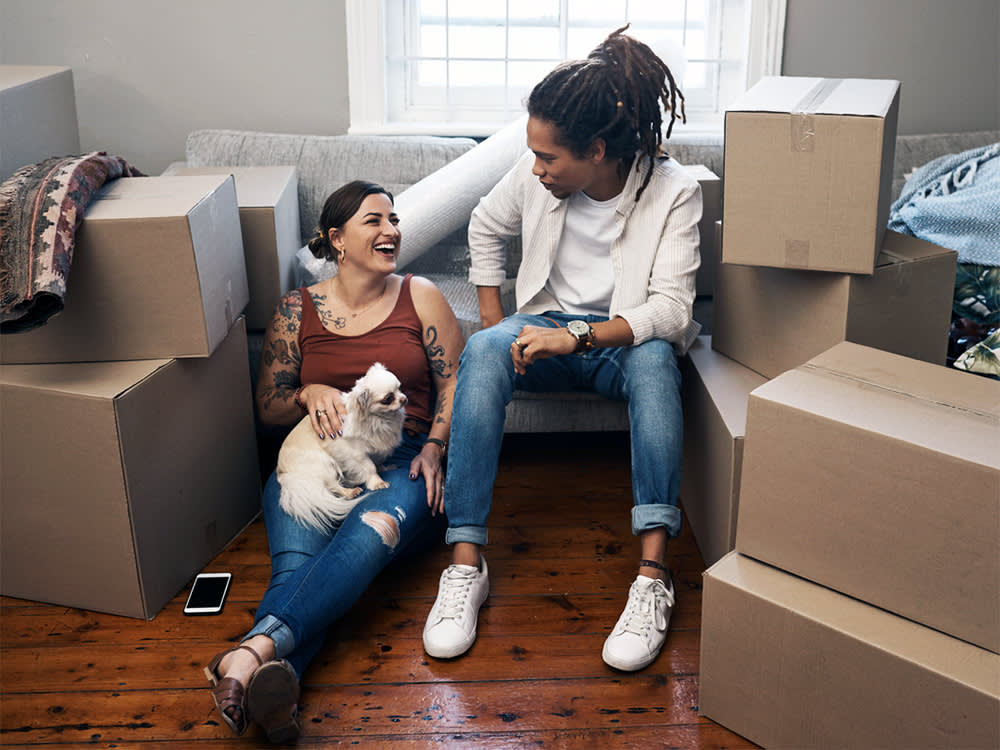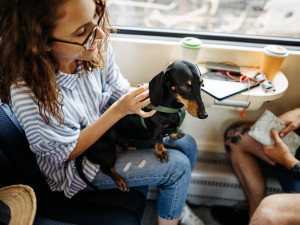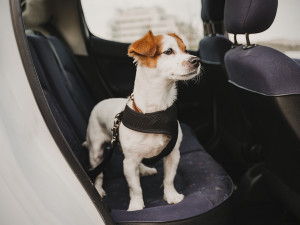Moving Abroad With Your Dog? Here’s Everything You Need To Know
Moving house is stressful at the best of times, but what happens if you want to move abroad with your dog? We consulted some experts to find out
Moving to another country is a life-changing decision – but there’s even more to think about when you have a dog. It can feel like a scary prospect in so many ways: will they like it where you want to move to? How will they travelopens in new tab to this new life? And how can you prepare them for it? Because it isn’t the same as moving down the road or somewhere else in the UK (and that’s stressful enough as it is – for the human and the dog).
But you can make it happen, as long as you do your research. You just need time, patience and planning to make it easy on you both. Here’s everything you need to know…
Get (totally free) deals for food, treats, accessories, tech and way more pet parenting must-haves.
Will your dog be OK in the country you want to move to?
First of all, consider the impact on your dog before you agree to moving anywhere, says dog behaviourist, Louise Glazebrookopens in new tab. “If you’re moving to a hot climate with a French Bulldog, for example, you’ll need air-con in your new home,” she says. A French Bulldog is a brachycephalic dogopens in new tab, with a short nose, and they’re much more likely to overheat. “You’ll need to consider how happy that situation will make your dog.”
Then compare where you’re moving from to where you’re moving to – perhaps it’s rural to cityopens in new tab or city to rural, “this will have an impact,” says Louise. “You can’t just land and expect your dog to be OK.” Louise says that you need to allow for ‘decompression time’ – just because you understand the transition, doesn't mean your dog will. Decompression means going slowly, introducing your dog to their new location in small increments without any expectation.
Alison Hills from Ladyhayeopens in new tab, which helps people move their pets all over the world, agrees. “They’re putting their trust in you,” she says. “When we go somewhere new, we’ve got a map to follow, we’ve got directions. Dogs don’t, we are their map.”
Mode of transport to your new destination
Once you’ve decided on the country, think about how you’re going to get there: plane, trainopens in new tab, bus, boat, caropens in new tab? Take into account your dog’s previous experience and the route you’ll be taking, says Louise. “If you’re travelling within Europe, perhaps you can driveopens in new tab for some of the journey to make a flight shorter,” she suggests.
Travelling by boat might seem like a simpler option than a flight, but you need to check with the company about its rules. “Some enforce that dogs need to be in kennels on the ship,” says Louise. “This can be distressing if they’re not used to it.”
Most likely, you’ll fly to your new home, especially if it’s outside of Europe, in the USA, Canada or Australia. But you might be worried that your dog will be loaded on to the plane like a suitcase. Alison reassures us that isn’t the case. “There's a separate hold for animals,” she says. “It’s heated, ventilated and there’s a dim light, like a nightlight, so they aren’t in the dark.”
On a flight your dog will travel in a crateopens in new tab – “as long as you condition them to that crate, they’re going to be fine,” assures Alison, who encourages anyone who’s worried about the process to look at the bigger picture. “A few hours on a flight, in their safe zone in their travel box, then they will be reunited with you,” she says. “Otherwise it means leaving them behind.”
Getting your dog ready for a flight
“You can't just expect your dog to 'do' the journey without any prep,” Louise explains. “I've worked with dogs for months to help them.” The key is getting them used to their travel crateopens in new tab, so order it many months before you fly. Louise suggests enlisting the help of a pet travel company, such as Pet Air UKopens in new tab or Ladyhayeopens in new tab, to help as the box will need to fit your dog’s measurements.
“Then you need to teach them that their travel box is a safe space, no matter what noises they hear around them,” says Alison. Put their blanketsopens in new tab in, let them play with their toysopens in new tab and eat their dinner in there. “But don’t close the door or use it as a punishment,” says Alison, “let them choose to come in and out.” Once you think they’re ready, close the door – “start with a few seconds and build up the time,” says Alison. “Use treatsopens in new tab every time they go in and come out.”
Then take them for a car trip in their box. “This gets them used to the movement,” says Alison. “Take them somewhere they’ll like, so they know that when they’ve been in the box they’ll get a treat at the end, like a walk on the beachopens in new tab.” Then, “try taking them to a building site and just sit there for a while,” suggests Alison. It mimics the sounds of an airport, which can be busy and noisy – you can also search for ‘cargo sounds’ on YouTube.
On the actual journey, put something that smells of home in with them. “Wear a T-shirt for a couple of days so it will have your full smell on it,” says Alison, that way they’ll feel like you’re close by. And remember each dog is different – “they take their own time to get used to it, so it’s down to you to put the work in,” says Alison.
Do rules differ depending on where you want to move to?
“All counties have their own rules when pets arrive, it depends on where you’re travelling to – some rules are stricter than others,” explains Alison, who recommends using a specialist pet travel company, as they know the rules and can help you navigate them. Alison has helped move dogs, cats and even birds from the UK to the USA, Canada, Europe, Australia, New Zealand, South Africa, Bermuda, India...
Moving pets to Australia is slightly more complicated than other places, “There are so many things to take into consideration,” says Alison. Enough time needs to be factored in for your dog to get checked by a vet: “Pets can’t travel until 180 days after a government-approved lab receives the blood for their rabies test.” On arrival, pets also need to spend 30 days in quarantine, whereas places such as Canada and the USA have no quarantine time.
Required vaccinations depend on where you’re travelling to, so you’ll need to check. “But regardless of where they’re travelling to, all pets should be microchipped, and all their usual yearly vaccinations and parasite treatments kept up to date,” says Alison.
Most importantly, think about what this move will look like for both you and your dog. Oh, and if you’re moving to a country that doesn’t have quarantine, book on the same flight as your dog, that way you will be there to meet them at the airport. “One of our customers could hear their dog barking as the plane landed,” chuckles Alison. Then you can all head off together for the start of a new adventure.
Breakdown of costs
The overall cost is going to vary wildly depending on where you're moving it. If you decide to go with a pet travel agency, you’ll need to enquire with them directly for the price – each will charge different amounts. Ladyhaye, for example, has an agency fee of £200. Then, there’s numerous other costs to consider, including an airline handling fee, a UK customs fee, X-ray security and even a meet-up fee for airport departure. You will also have to pay for quarantine, which will vary depending on the length of quarantine your desired location requires. Then, there’s the flight itself: “you’ll find that pet’s flights are always more expensive than human flights,” explains Alison, “depending on where they are travelling to, it can be as much as six times the price.”
Do I need a pet passport?
Only pets from the EU can obtain a passport. Dogs travelling from the UK require a DEFRA Export Health Certificate. “Vets charge different rates for this, anything from £100 to £500,” says Alison. This must be completed by your vet before departure date, times can vary for each.
Other points to consider
“Smaller dogs may qualify for travelling in the cabin with you,” says Louise, but they must meet certain criteria, which will need to be checked with the airline you’re planning on flying with.
Not all countries are pet-friendly and some have limits on where they can go in public, so you should thoroughly research this before a move. “All information is on each country’s government website,” explains Alison.
Rescue dogs can move, too. “We’ve helped move lots of rescue dogs who have anxiety,” says Alison. “You just have to prepare them for it.” A short flight can lead to a lifetime of happiness.
“If your dog has a short nose, for example, an English or French Bulldog, these are higher risk for flying, some airlines may not take them,” says Louise, so you’ll need to check.
You can’t give your dog any anti-anxiety medication before they fly. “No sedation, no sedatives, anything like that,” says Alison. “You don’t know what the altitude is going to do to their body system with medication in it.”
Rule out any medical grounds why your dog shouldn’t fly. If your dog has been diagnosed with a heart murmur for example, it might be too dangerous for them, so seek guidance from your vet.







